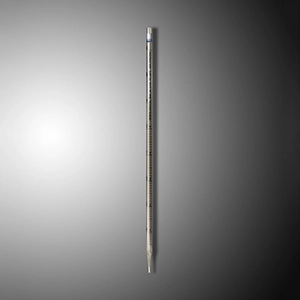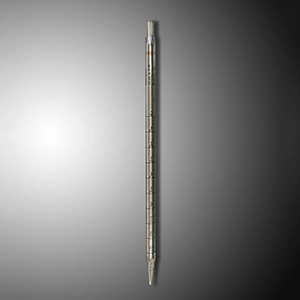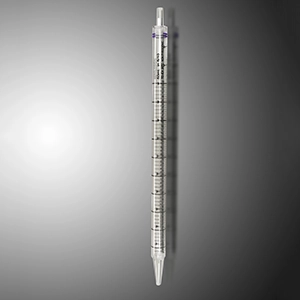Serological Pipettes
Available in 1.0, 2.0, 5.0, 10.0, 25.0 , 50.0ml and 100.0ml
Graduations are calibrated for accurate dispensing to within ±2%
Different color ring for easy identification
Bidirectional graduations on the pipets provide added applicability
Negative graduation allows additional working volume
All pipets are supplied with a filter plug
Strict consistency tested
Non-pyrogenic
peel-to-open wrap with lot number for quality control and traceability
gamma irriadiation sterilized
What Are Serological Pipettes And How Do You Use Them?
Click here to skip the explanation and take me to EarthOx Serological Pipettes!
(Scroll to the bottom of the page to see our serological pipette selection.)
What Is A Serological Pipette?
A serological pipette is a temperature-controlled, laboratory instrument used for transferring milliliter volumes of liquid. They work like drinking straws – they the allow liquids to be ‘sucked up’ one end. The volume markings are calibrated to be accurate at 20-25C (68-77F), or standard room temperature. They are either plastic, sterile and disposable, or glass, sterilizable and reusable.
They are commonly used in Biology courses. The different types are, TC – To Contain – and TD – To Deliver. A TC pipette delivers all the volume of the liquid in the tip and needs to be ‘blown out’, to get every last drop out. Blowing is done using the associated pump, and never your mouth. TD pipettes are calibrated for the whole tip to drain.
Pipette Dispensors
A pipette dispenser is used with serological pipettes. A pipette dispenser facilitates the liquid transfer through the creation of a partial vacuum. Dispensers can be used with a variety of different pipette sizes. All pipettes require the use of a dispenser for liquid transfer. The dispenser takes away the ancient technique of mouth pipetting. This primitive method for transferring liquids, isn’t recommended. It can lead to the liquid entering the oral cavity and causing serious adverse side effects.
The pipette bulb – a type of pipette dispenser – offers the least amount of accuracy and is usually used with glass serological pipettes that transfer non-specific volumes of liquid.
The pipette pump – is also used with a glass pipette. It allows a more precise way to regulate the liquid volume. They are particularly useful for dispensing repeat volumes of a solution.
The most common type of dispenser is called a pipet-aid. It has a nose cone where the pipette attached to and is also where the filter is located. The filter protects the inside of the pipet-aid from the liquid and maintains sterility. The handle of a pipet-aid is where two triggers are found – the top trigger is depressed for aspirating liquids and the bottom is for dispensing them. They often come with settings that can control the speed with which the liquid is dispensed. Some pipet-aids have cords, but most are battery operated. Some come with a stand that attaches to the handle, allowing the pipet-aid to rest on its side and you won’t have to remove the pipette.
Blow-Out Pipette
On each instrument, there are either frosted rings or two rings that indicate that the pipette you are using is a ‘blow out’ pipette. A ‘blow-out’ pipette means that after all the liquid is drained, the remaining liquid must be forced out.
There are labels to indicate the size and measurement graduations of the pipette – which are:
10 mL in 1/10
5 mL in 1/10
1 mL in 1/100
The frosted bands shoulnd’t be confused with thicker, colored rings or dots – which is a manufacture’s code for the maximum volume.
Mohr Pipette
This type of pipette is called the Mohr pipette. They aren’t ‘blow-out’ types, nor are the tips part of the measurement. They are only used to measure using a point-to-point delivery system.
The Correct Way To Un-Wrap And Use A Sterile Serological Pipette
When working with a sterile pipette, the operations are done aseptically. If you are working with non-sterile pipettes, you should work aseptically anyway, as a matter of routine in order to practice the technique.
-First things first, don’t open the sterile sleeve, look through the wrapper and check to make sure the tip isn’t cracked or chipped. Also, if the wrapper has been damaged, don’t use it.
-Open the wrapper, then remove the pipette and insert the top, wide end into a pipette-aide.
-Fill the instrument a bit above its capacity line desired and slowly lower the meniscus to that capacity line.
-Remove the pipette from the vessel and – allowing the outside of the pipette to gently touch the inner lip of the vessel – remove any adherent. To avoid introducing air bubbles, don’t touch the tip of the pipette.
-Aseptically move the pipette to the receiving vessel and deliver the contents. You won’t need to “blow-out” if you are pipetting a volume between two measurement lines. You will, however, need to “blow-out” the remaining liquid in the tip if you need to deliver the entire contents of the pipette.
Measuring and Reading Volumes
Each pipette has printed, on the neck, the specifications that indicate:
–The Maximum Volume of liquid that can be transferred.
–The Size of The Divisions on the pipette.
–The Temperature at which calibrations were made.
–Specifies if it is either a ‘TD’ or ‘TC’ pipette.
When loading the pipette, the volumes read at the bottom forms on top of the column of liquid. When determining the volume, pay attention the number sequence – they may be printed tip to top, or bottom to tip, and sometimes, both. Always, view the instrument at eye level with the pipette head vertical and perpendicular to the ground, when reading the volume. The volume may be measured when all the liquid is drained completely, or by point-by-point delivery.
Recommended Links
The Use Of Serological Pipettes In The Lab
The Different Types of Laboratory-Pipettes
Showing 1–9 of 14 results
-
Serological Pipettes
Serological Pipettes – 100 ml – Sterile – Individually packaged (50 pipettes per case)
Original price was: $143.00.$100.00Current price is: $100.00. -
Serological Pipettes
Serological Pipettes – 5 ml – Sterile – Individually packaged (200 pipettes)
Original price was: $78.00.$29.00Current price is: $29.00. -
Serological Pipettes
Serological Pipettes – 10 ml – Sterile – Individually packaged in Bags of 50 (200 Pipettes/case)
Original price was: $90.00.$59.00Current price is: $59.00. -
Serological Pipettes
Serological Pipettes – 5 ml – Sterile – Individually packaged in Bags of 50 (200 pipettes)
Original price was: $88.00.$49.00Current price is: $49.00. -
Serological Pipettes
Serological Pipettes – 50 ml – Sterile – Individually packaged (100 pipettes per case)
Original price was: $130.00.$69.00Current price is: $69.00. -
Serological Pipettes
Serological Pipettes – 50 ml – Sterile – Indiv. pkgd (Bags of 20) (100 pipettes per case)
$145.00 -
Serological Pipettes
Serological Pipettes – 25 ml (308.5mm) – Sterile – Individually packaged (150 pipettes per case)
Original price was: $120.00.$55.00Current price is: $55.00. -
Serological Pipettes
Serological Pipettes – 10 ml – Sterile – Individually packaged (200 Pipettes/Case)
Original price was: $80.00.$39.00Current price is: $39.00. -
Serological Pipettes
Serological Pipettes – 100 ml – Sterile – Individually packaged (10/bag x5) (50 per case)
$157.00






